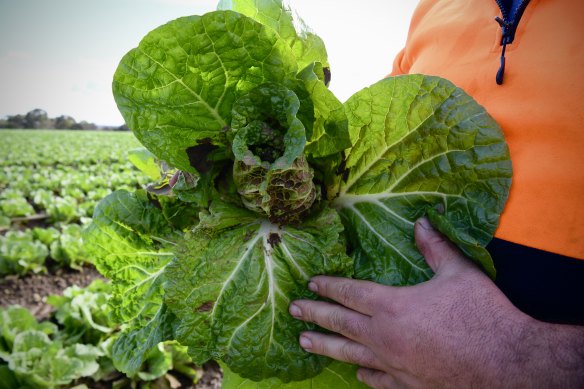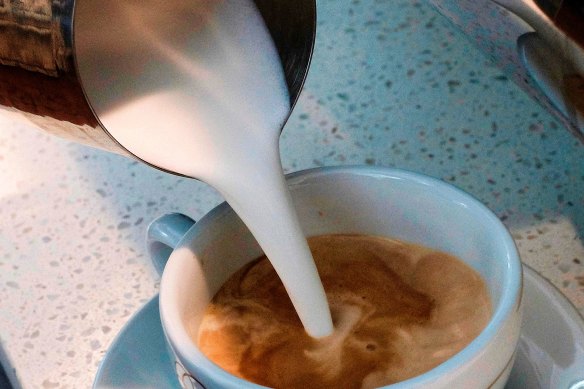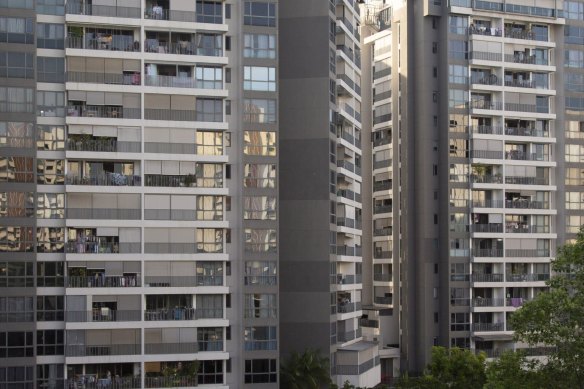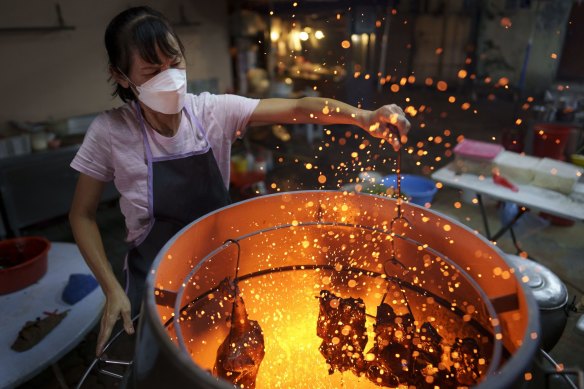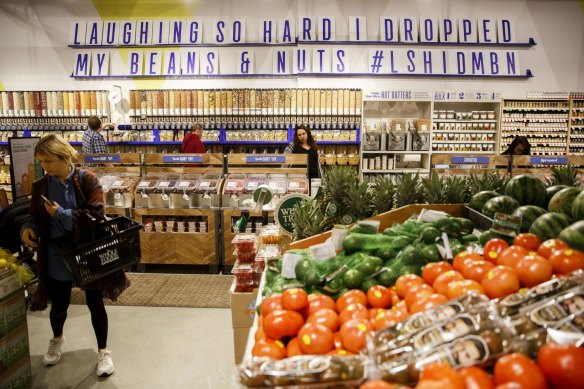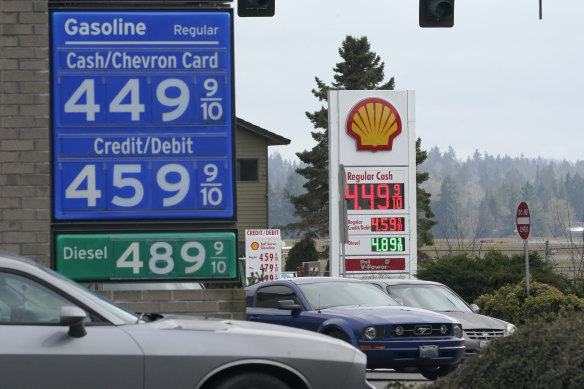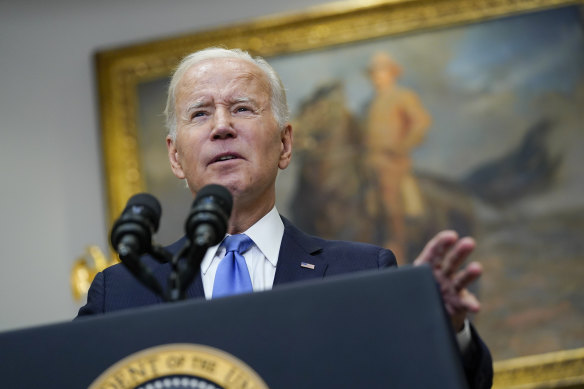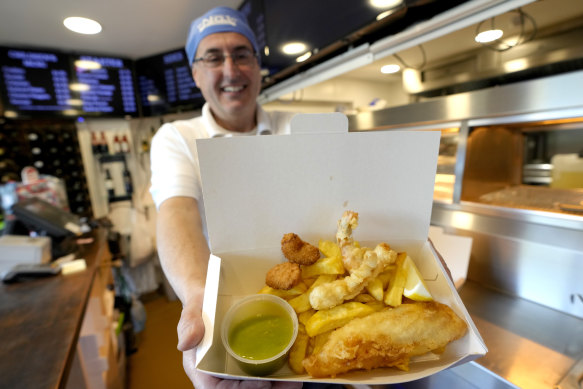Six back-to-back interest rate hikes have left Aussie mortgage holders reeling from the need to find $1030 extra a month to meet repayments on a $750,000 loan.
Renters are faring little better: median unit rents are up 12 per cent over the year in Sydney and 13 per cent in Melbourne, according to CoreLogic data.
At least the price of iceberg lettuce has come back to earth.Credit:SMH
Perhaps the only bright spot is the price of iceberg lettuce has fallen back to $2.90.
Australians are far from alone in feeling the pinch of the cost of living crisis now gripping the globe, sparked by a quadruple whammy of COVID-induced supply shortages, the war in Ukraine, natural disasters and now rising interest rates to cool price pressures.
But while Aussie shoppers are suffering, CommSec’s chief economist Craig James, says our cost of living pales in comparison with some other nations. “I don’t believe cost of living is worse here,” says James. “The standard of living must be equated with the cost of living and Aussies have a very high standard of living and costs, in comparison, are relatively cheap.”
While international price comparisons are difficult, given currency fluctuations, a rough snapshot of local prices by our foreign correspondents this week suggests Aussie caffeine addicts are getting a pretty good deal – paying around $4 for a takeaway coffee in Sydney and $4.50 in Melbourne – compared with $8 in America, more than $7 in Singapore and $6.50 in Beijing.
In the US a coffee can set you back $8.Credit:AP
Power prices are also lower, at an average of 29 cents per kilowatt hour in Sydney and 21 cents in Melbourne, according to Canstar data, compared with 89 cents in London and 68 cents in Berlin.
And there’s potentially more good news to come. Easing freight prices for global goods – a major driver of higher costs since the pandemic – suggest inflation could soon be at its peak, says James. The less positive news is that inflation-fighting central banks may accidentally tip us into a global recession. “In a few years’ time, I think there is the risk that we will be fretting over disinflation,” says James.
In the meantime, we asked our foreign correspondents to report back on the pressures facing household budgets across the globe. Perhaps it will make you feel a little better about your own budget pressures. Or, at the very least, you may feel less alone as you navigate the cost of living crisis now gripping the globe.
COVID lockdowns curb Chinese prices
If you want to avoid rapidly rising prices, China is the place to be – if you don’t mind ongoing COVID-lockdowns, that is. But even Chinese consumers are feeling the pinch on some items, as North Asia Correspondent, Eryk Bagshaw, reports:
While much of the rest of the world grapples with surging inflation, China – in the midst of ongoing COVID-lockdowns inflicting self-harm on the economy – has contained inflation to between 2-3 per cent.
Inflation fell to 2.5 per cent in August year-on-year from 2.7 per cent a month earlier. Fuel prices, which are controlled by state economic planners, dropped as did food despite the drought gripping parts of the country.
“[The] zero-COVID policy is a major deflationary force, which supports production but saps demand,” said Macquarie Group’s chief China economist Larry Hu.
Pork, a key ingredient in many Chinese meals, is always a sensitive price point. It jumped by 22.5 per cent in August on the back of more people cooking at home, forcing the Chinese government to dip into the national meat reserves to bring prices back down in time for the holidays in September and early October.
Falling demand has hit the property sector the hardest with new home prices declining for the twelfth consecutive month in August. That has triggered concerns about a property market collapse as developers abandon empty apartment blocks and buyers are left holding empty assets.
Externally, China’s rolling COVID restrictions are having an upward inflationary impact outside of its borders by tightening shipping supply lines and limiting the flow of goods out of its ports – pushing up prices for electronics and other consumer items in Australia and around the world.
Rice and rents surge in South-East Asia
From protests in Jakata over rising fuel costs to Singapore’s rental crisis, many Asian nations are grappling with price pressures, reports South East Asia Correspondent, Chris Barrett:
Over a few cheap beers this week at Colbar, a traditional kampong-style eatery in the Singapore suburbs, one person at our table complained about their landlord raising the rent on their one-bedroom apartment by $Sing800 ($867), or about 25 per cent.
“Take it,” was the response from the rest of the group.
In Singapore, skyrocketing rental prices are the talk of the town. The housing market in the south-east Asian financial hub is not cheap at the best of times. In the past year, however, rent has been going through the roof.
Driven by new arrivals including from Hong Kong, as well as Singaporeans upgrading to condominium apartments usually occupied by expatriates, prices are up 27 per cent in the past year.
Rents are soaring in Singapore.Credit:Bloomberg
Now, two-bedroom condo units in Orchard, the red dot’s famous shopping centre, are going for as much as $Sing9000 a month and when tenants’ leases are expiring their rents are being forced up by as much as 40 per cent.
In Singapore, already eye-watering private school fees paid by expats and their employers are also on the rise as inflation has reached a 14-year high of 5.1 per cent, and the cost of owning a car is up 24 per cent in a year.
At the other end of the scale, the rising price of the city-state’s famous chicken rice has also been in the news since Malaysia, concerned about its own domestic supply, suspended chicken exports in June.
Singapore until then imported 3.6 million chickens a month from its closest neighbour – about a third of what it needs – and has since had to strike deals with Indonesia instead to try and cover the shortfall.
Malaysia has suspended chicken exports.Credit:AP
In Malaysia, where inflation hit 4.7 per cent in August, consumers are feeling the pinch from the depreciating value of its currency, the ringgit, most keenly at the supermarket. Everything from carrots, which are imported from Australia, to bottled cooking oil has gone up noticeably, the kitchen frying staple impacted by a shortage of workers to harvest palm oil as well as global push factors like the war in Ukraine.
The cost and supply of edible oil has also been a big deal this year in Indonesia, whose government responded by imposing a price cap and then a controversial, short-lived export ban.
More recently, it has been fuel and rice that are putting the squeeze on people in south-east Asia’s largest economy.
Thousands of protesters took to the streets in Jakarta and other cities last month after fuel subsidies were cut to relieve pressure on the government budget. It was a decision that sent prices at the bowser up by 30 per cent, hurting the country’s 130 million motorcycle users in particular.
The latest pressure point is rice, with a kilogram in Jakarta’s main market surging from 9500 rupiah (96 cents) to 13,600 rupiah in the past month.
Cost of living to swing US mid-terms
The Biden administration’s Inflation Reduction Act is aimed, in part, at cooling price pressures. But Americans still face rapidly escalating costs relative to wages and may soon take out their frustration at the polls, as North America Correspondent, Farrah Tomazin, reports:
It’s a weekday morning in Washington and a woman in a pink sweatsuit is examining a shelf of fruit at Whole Foods, one of America’s main supermarket chains.
Rising prices are hurting shoppers at Whole Foods stores in the US.Credit:Patrick T. Fallon
She picks up a small plastic container of pre-cut organic pineapple cubes, shaking her head at the $US13.96 price tag – the equivalent of almost $22 in Australia.
“This is why we call this grocery store Whole Pay Cheque, instead of Whole Foods,” the 43-year-old social worker from south-east DC tells me. “The prices are astronomical.”
Walk into any supermarket, furniture outlet or petrol station across the country and you’re likely to hear similar concerns.
With national inflation hitting a 40-year high this year, countless Americans are feeling the pinch as the cost of necessities spikes faster than many average incomes.
In supermarkets, the price of almost everything on the shelf has surged. Eggs, for example, were 40 per cent higher in August than the same last year, according to the latest consumer price index figures. Chicken and bread rose by about 16 per cent over the same period, and even processed fruits and vegetables spiked by more than 14 per cent.
US petrol prices surged mid-year but have moderated since then.Credit:AP
At the bowser, average US gas prices reached a record high in June, topping $5 per gallon. They’ve come down since – the national average was sitting at $3.86 a gallon by Thursday this week – but the decision of oil-producing nations on Wednesday to cut production by 2 million barrels a day has renewed anxiety about potential future pain.
As for housing affordability? Rents continue to rise at the fastest pace in decades – a record 11.3 per cent last year, according to real estate research firm CoStar Group – fuelled by a lack of supply and higher post-pandemic demand.
The Biden administration says it has sought to alleviate some of the price pain by attempting to fix broken supply chains, giving the Federal Reserve “full reign” to fight inflation, and tapping into the strategic oil reserve – something it may have to do again in wake of OPEC’s production cuts.
It also recently passed the so-called Inflation Reduction Act – a sweeping new law that aims to lower prescription drug costs, tackle climate change, and raise taxes on billion-dollar corporations.
With the midterm elections looming next month, President Biden will be hoping for better news on cost-of-living pressures.Credit:AP
“This is the single most important legislation passed in the Congress to combat inflation and one of the most significant laws in our nation’s history,” Biden said last month at a White House ceremony to showcase the reforms.
But the country’s economic reality is somewhat harsher than the President’s rosy messaging – particularly for low-income families and Black and Hispanic Americans, because a disproportionate share of their income goes toward essentials such as housing, transportation and food.
And with the midterm elections in five weeks, the cost of living in the US could end up determining who controls Congress after November 8 – and in turn, the fate of Joe Biden’s first-term agenda.
Britons fork out $20 for fish and chips
And finally to London, where a grief-stricken nation is also confronting some of the highest power prices in the world and a rapidly escalating price tag for the nation’s most loved dish, as Europe Correspondent, Rob Harris, reports:
The fish and chip shop, a staple of British cuisine, is bearing the brunt of an economic crisis which threatens to cripple Britain and Europe this winter.
The traditional “chippy” has been smashed by rising energy bills, dramatic increases in the wholesale costs of vegetables and the British government imposed tariffs on Russian fish in response to Moscow’s invasion of Ukraine.
An increase in prices and a 25 per cent tariff on all seafood imported from Russia – where about a third of all imported white fish in Britain is sourced from – has had a devastating effect on the industry. In turn, the price of a meal has increased from an average of £8.50 ($14.80) to £11.50 ($20.05) nationally.
Fish and chips is becoming exorbitantly expensive in Britain.Credit:AP
Industry bosses fear the cost of living crisis could force 3,000 of Britain’s estimated 10,500 chippies to close in Britain’s cities and villages could also be lost.
Potato crops were also ravaged by the UK’s heatwaves this summer, which saw a record-breaking 41 degrees Celsius being recorded in some parts of the country. The increase in wholesale prices of potatoes have been passed on to customers in restaurants, takeaways, and supermarkets.
But it is on their power bills that Britons are feeling perhaps the biggest pinch, with an average price per kilowatt hour for electricity of 89 cents, compared with 29 cents in Sydney and 21 cents in Melbourne.
Prime Minister Liz Truss has intervened to freeze energy prices for households for two years. In early September, Truss announced that the average annual bill for a typical household would be capped at £2,500 to protect consumers from the intensifying cost of living crisis and a scheduled 80 per cent rise in the cap to £3,549.
Britain’s Prime Minister Liz Truss has announced support for consumers being battered by high energy prices – but the cost to the public purse is uncertain.Credit:AP
The ultimate cost of the policy is uncertain as it is highly dependent on the wholesale cost of gas, which has soared since Russia’s invasion of Ukraine put a squeeze on already-volatile international markets. Ballpark projections had put the cost anywhere from £100 billion to £150 billion.
Richard Coleman Ord, a fifth-generation chip shop owner from, Colmans, in South Shields, says soaring prices had been even tougher on business than the pandemic.
“The potatoes, the fish, the oil, all the commodity prices have gone up beyond our wildest dreams – even though we’ve been in business for 60 years,” he said.
“It should be the same for this crisis because, to be honest with you, it’s worse than the pandemic. It’s far more serious for businesses than the pandemic ever was.”
The Morning Edition newsletter is our guide to the day’s most important and interesting stories, analysis and insights. Sign up here.
Most Viewed in National
From our partners
Source: Read Full Article
